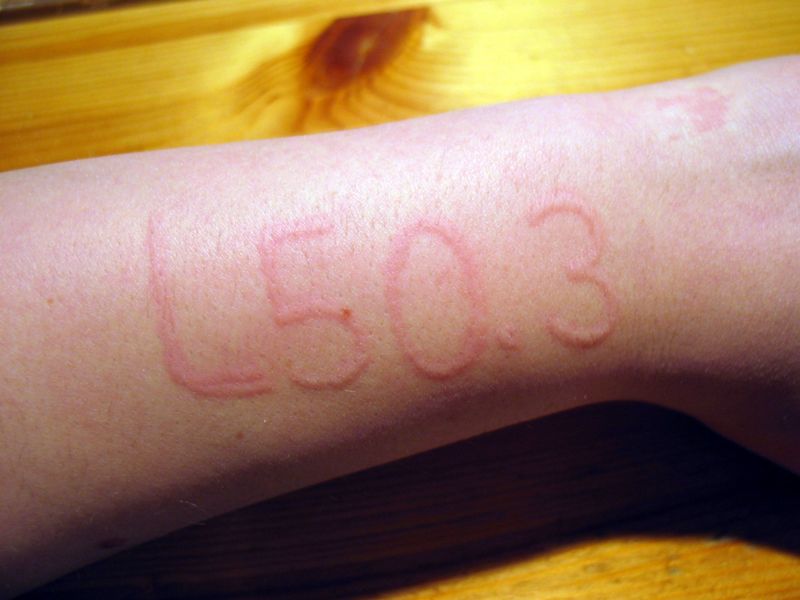Dermatographic
| Dermatographic urticaria | |
 | |
|---|---|
| Dermatographic urticaria is sometimes called "skin writing". | |
| ICD-10 | L50.3 |
| ICD-9 | 708.3 |
| OMIM | 125635 |
| DiseasesDB | 12736 |
| eMedicine | derm/446 |
Dermatographic urticaria (also known as dermographism, dermatographism or "skin writing") is a skin disorder seen in 4–5% of the population and is one of the most common types of urticaria[1], in which the skin becomes raised and inflamed when stroked or rubbed with a dull object[2].
Presentation
The symptoms are thought to be caused by mast cells in the surface of the skin releasing histamines without the presence of antigens, due to the presence of a weak membrane surrounding the mast cells. The histamines released cause the skin to swell in the affected areas.
This weak membrane easily and rapidly breaks down under physical pressure causing an allergic-like reaction, generally a red wheal (welt) to appear on the skin. It can often be confused with an allergic reaction to the object causing a scratch, when in fact it is the act of being scratched that causes a wheal to appear. These wheals are a subset of urticaria (hives) that appear within minutes, accompanied by a sensation of burning, and itchiness. The first outbreak of urticaria can lead to others on body parts not directly stimulated, scraped or scratched. In a normal case the swelling will reduce itself with no treatment within 15-30 minutes, but in extreme cases, itchy red wheals may last anywhere from a few hours to days.
On March 14, 2008, ABC News presented a report on an artist with dermatographism who uses her skin as her medium. [3]
Causes
Dermatographism can be caused by stress, tight or abrasive clothing, watches, glasses, energetic kissing, heat, cold, or anything that causes stress to the skin or the patient. In many cases it is merely a minor annoyance, but in some rare cases symptoms are severe enough to impact a patient's life.
Treatment
It can be treated by antihistamines which prevents the histamine from causing the reaction, or cromoglycate, which prevents the histamine from being released. The underlying cause of dermographism is not known, and can last for many years without relief. 95% of chronic cases are never solved. Sometimes the condition goes away, sometimes it stays forever. It is not a life threatening disease and is not contagious (transferable to other persons).
Not taking hot baths or showers may help if it is generalized (all over) and possibly for localized (in a specific area) If not taking showers helps, you may have a condition called shower eczema. If it mainly affects your head you may have psoriasis. In rare cases, allergy tests may uncover substances the patient is allergic to. Using biodegradable or hypo-allergenic soaps and laundry supplies may help.
References
- ↑ Jedele, KB; Michels, VV (1991), "Familial dermographism", American Journal of Medical Genetics, 39 (2): 201–3 PMID 2063925
- ↑ Kontoi-Fili K., Borici-Mazi R., Kapp A., et al. "Physical urticaria: classification and diagnostic guidelines." An EACCI position paper. Allergy 1997;52:504–13.
- ↑ ABC News: A Skin Disorder Becomes Canvas for Art[1]
External links
| This cell biology article is a stub. You can help Wikipedia by expanding it. |